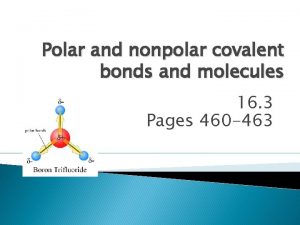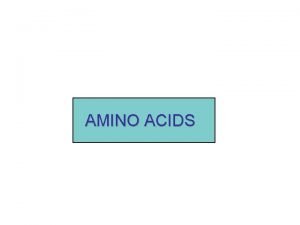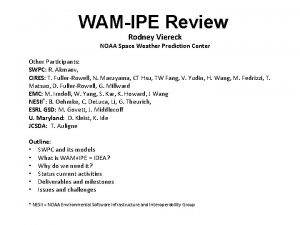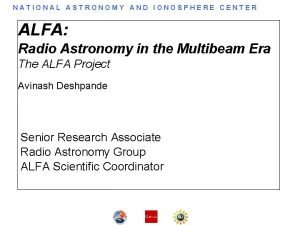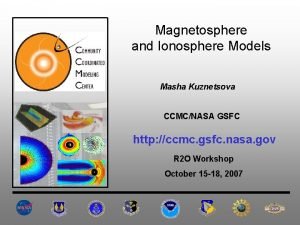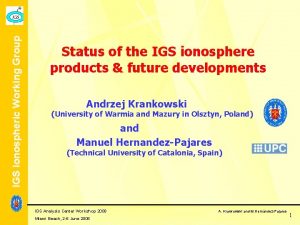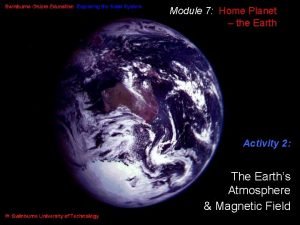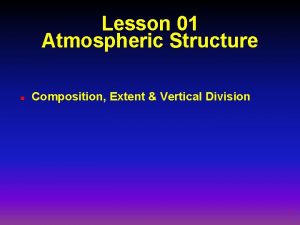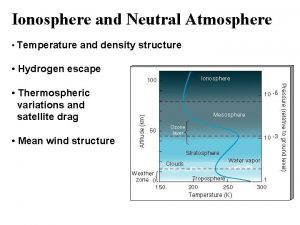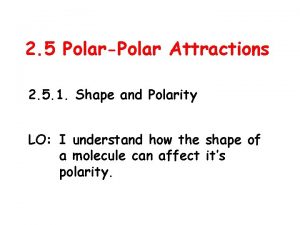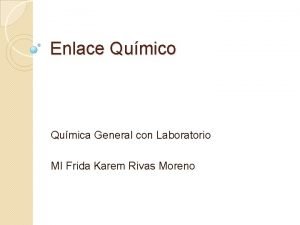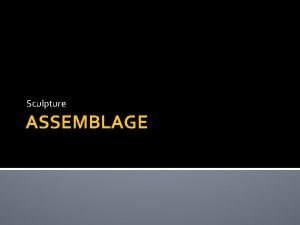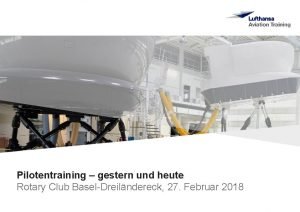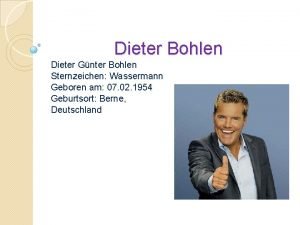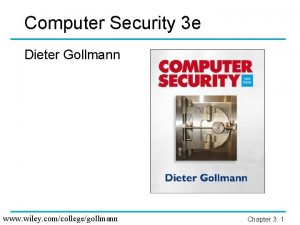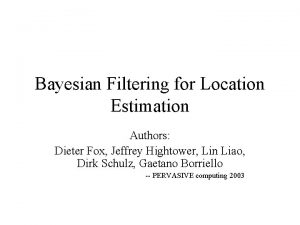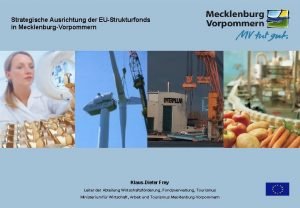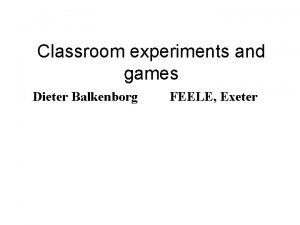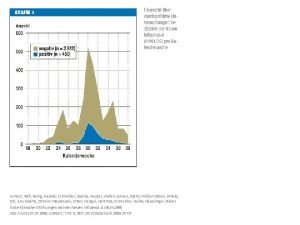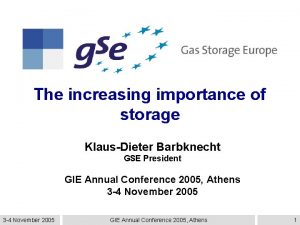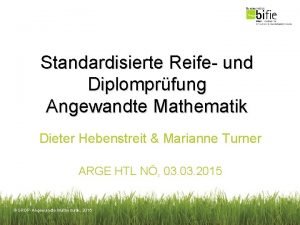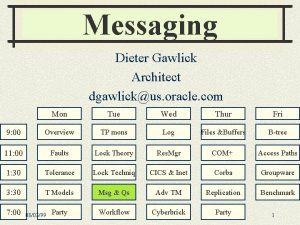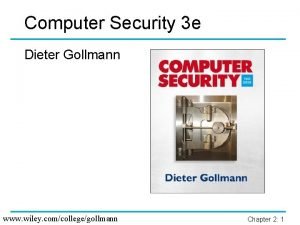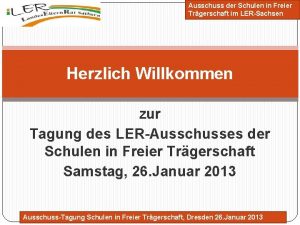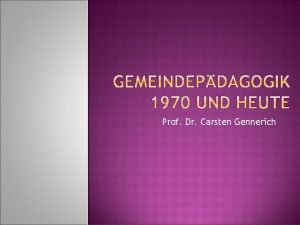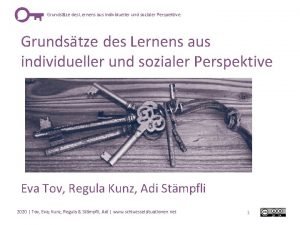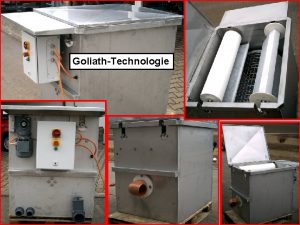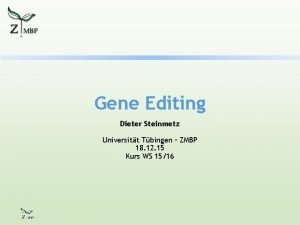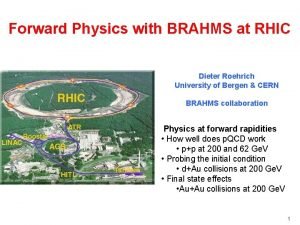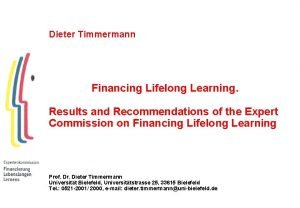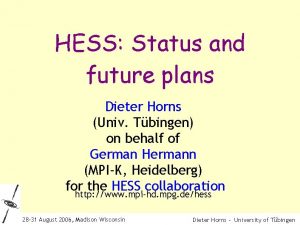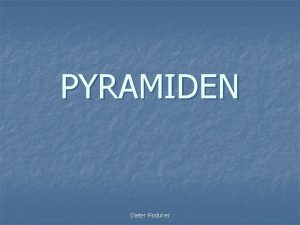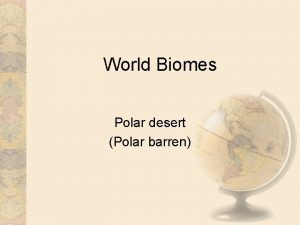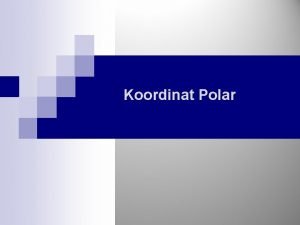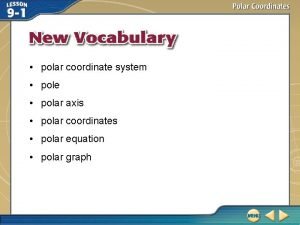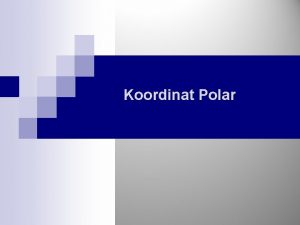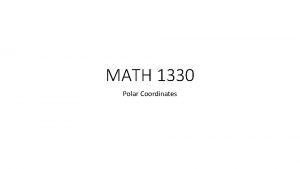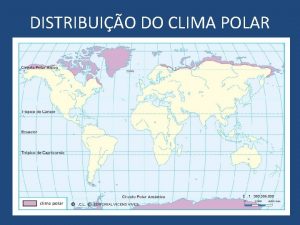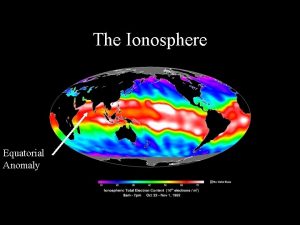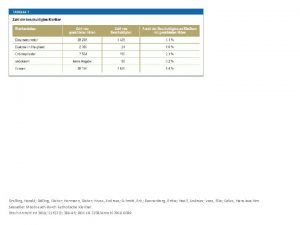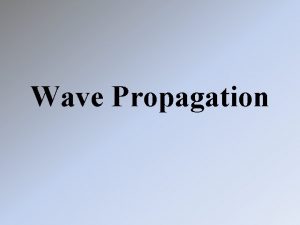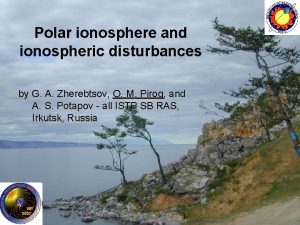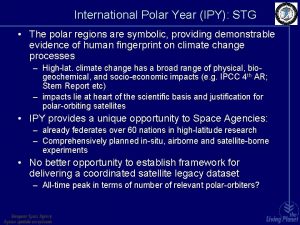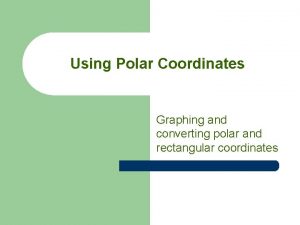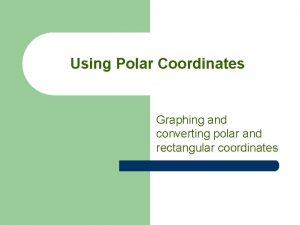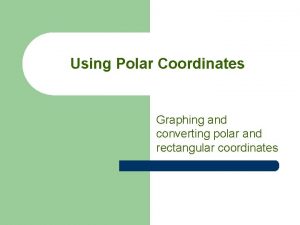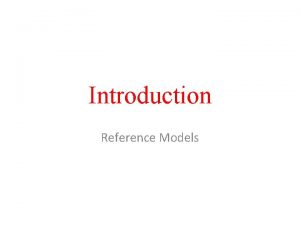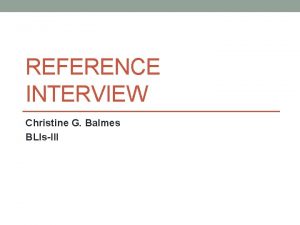International Reference Ionosphere and the Polar Ionosphere Dieter























![Inclusion of Auroral Boundaries in IRI Authors Image data: Feldstein and Starkov [1967] Holzworth Inclusion of Auroral Boundaries in IRI Authors Image data: Feldstein and Starkov [1967] Holzworth](https://slidetodoc.com/presentation_image/fb3af3f41263bee531fc2137862b4810/image-24.jpg)





















- Slides: 45

International Reference Ionosphere and the Polar Ionosphere Dieter Bilitza GSFC, Code 672, Greenbelt, Maryland George Mason University, Virginia Ø Ø Introduction and Current Status Polar Ionosphere Auroral Characteristics from TIMED/GUVI IRI-2007 and some Applications Polar Gateways Meeting Barrow, Alaska, Jan 23 -29, 2008 http: //IRI. gsfc. nasa. gov 1

INTERNATIONAL REFERENCE IONOSPHERE (IRI) Terms of Reference • The IRI Working Group was established to develop and improve a reference model for the most important plasma parameters in the Earth ionosphere. • IRI is a joint project of COSPAR and URSI. COSPAR’s (Committee on Space Research) prime interest is in a general description of the ionosphere as part of the terrestrial environment for the evaluation of environmental effects on spacecraft and experiments in space. URSI’s (International Union of Radioscience) prime interest is in the electron density part of IRI for defining the background ionosphere for radiowave propagation studies and applications. • The model should be primarily based on experimental evidence using all available ground and space data sources and should not depend on the evolving theoretical understanding of ionospheric processes. But theoretical considerations can help to find the appropriate mathematical functions, to bridge data gaps and for internal consistency checks. • As new data become available and as older data sources are fully evaluated and exploited, the model should be revised in accordance with these new results. • Where discrepancies exist between different data sources the IRI team should facilitate critical discussions to determine the reliability of the different data bases and to establish 2 guidelines on Meeting which data should be used ionospheric modeling. http: //IRI. gsfc. nasa. gov Polar Gateways Barrow, Alaska, Janfor 23 -29, 2008

P. Bradley, M. Rycroft, Lj. Cander (U. K. ), K. Rawer, W. Singer (Germany), A. Alcayde, R. Hanbaba (France), B. Zolesi, S. Radicella (Italy), M. Friedrich (Austria), E. Kopp (Switzerland), D. Altadill (Spain) L. Triskova, V. Truhlik (Czech Rep) I. Kutiev (Bulgaria) I. Stanislawska (Poland), S. Kouris (Greece) A. Danilov V. K. Depuev T. Gulyaeva G. Ivanov-Kholodny K. Ratovsky A. Mikhailov B. Reinisch D. Bilitza T. Fuller-Rowell K. Bibl X. Huang J. Sojka D. Anderson V. Wickwar L. Scherliess M. Codrescu S-R Zhang C. Mertens K. Oyama K. Igarashi S. Watanabe W. Weixang M. -L. Zhang S. -Y. Su Kyoung Min S. Pulinets M. Abdu R. Ezquer M. Mosert de Gonzalez O. Obrou J. Adeniyi IRI Working Group Members A. Poole, L. -A. Mc. Kinnell Polar Gateways Meeting Barrow, Alaska, Jan 23 -29, 2008 K. Mahajan S. P. Gupta P. K. Bhuyan P. Wilkinson P. Dyson B. Ward http: //IRI. gsfc. nasa. gov 3

2004 2005 Paris, France C 4. 2 Advances in Specifying Plasma Temperatures and Ion Composition in the Ionosphere Ebro, Spain New Satellite and Ground Data for IRI and Comparisons with Regional Models In press Oct 16 -20 2008 Volume 39 Issue 5 2007 C 4. 2 - Solar activity variations of ionospheric parameters. 2006 2007 Volume 37 Issue 5 2006 Prague, Czech Republic New Data for Improved IRI TEC representation IRI/COST Workshop: Ionosphere – Modeling, Forcing and Telecommunications, In preparation COSPAR GA, Montreal, Canada, July 13 -20 C 4. 2 - Updating IRI with ground and space data URSI GA, Chicago, August 9 -16 G 02 – Density Profiling and Models Polar Gateways Meeting Barrow, Alaska, Jan 23 -29, 2008 http: //IRI. gsfc. nasa. gov 4

International Reference Ionosphere Monthly averages in the altitude range 50 -1500 km: + Electron density + Electron temperature + Ion composition (O+, O 2+, NO+, Cluster+, N+, He+, H+) [charge neutrality: Ne = ∑ni ] + Ion temperature + Ion drift (currently only equatorial vertical F-region drift) + spread-F occurrence probability (currently limited to South-American sector) Polar Gateways Meeting Barrow, Alaska, Jan 23 -29, 2008 http: //IRI. gsfc. nasa. gov 5

Data Sources Instrument Platform Ionosondes Worldwide Network Used for Comments Ne from E to F 2 Fifties to now Incoherent Jicamarca, Ne profile Scatter Arecibo, (E- valley) Radar St. Santin, Te, Ti Millstone. H. , Malvern, Topside Sounder Insitu Rocket Few radars, many parameters Alouette 1, 2 Ne topside ISIS 1, 2 profile newer data from Ohzora, ISS-b, IK-19 AE-C, -D, -E Ne topside many more: Aeros-A, -B profile, Ti, DMSP, OGO IK-24, DE-2 ion comp. Hinotori data Ne D-region, sparse compilations Ion comp. data set Polar Gateways Meeting Barrow, Alaska, Jan 23 -29, 2008 http: //IRI. gsfc. nasa. gov 6

Build-up of IRI electron density profile Mathematical functions: Global Variations: Spherical harmonics, special functions Time Variations: Fourier, simple sin/cos, step-functions Height Variations: Epstein functions Polar Gateways Meeting Barrow, Alaska, Jan 23 -29, 2008 Normalized to E and F peaks Global models for fo. F 2/Nm. F 2, fo. F 1/Nm. F 1, fo. E/Nm. E hm. F 2/M(3000)F 2, hm. F 1 , hm. E http: //IRI. gsfc. nasa. gov 7

Ionosonde stations represented on NGDC CD-ROM Digisonde stations Polar Gateways Meeting Barrow, Alaska, Jan 23 -29, 2008 http: //IRI. gsfc. nasa. gov 8

Middle and Low Latitudes: Good data foundation; Well tested and evaluated; Good description of variations with height, latitude, longitude, local time/solar zenith angle, season/month, solar and magnetic activity; Now considered the standard (ISO and ECSS). High Latitudes (auroral, polar): Sparse data record; Only few modeling efforts; Need to consider dependence on IMF and magnetospheric magnetic field; Highly variable; Modeling needs to include representation of many special features, like troughs, ovals, holes, crests (density/temperature enhancements and depletions); IRI provides background ionosphere based on few high-latitude ionosondes; Modeling of auroral and polar ionosphere Polar Gateways Meeting Barrow, Alaska, Jan 23 -29, 2008 http: //IRI. gsfc. nasa. gov 9

Auroral and Polar Ionosphere • The solar wind, consisting mainly of protons and electrons moving at ultra-sonic speeds of 400 800 km/s (more than a million miles per hour). • The solar wind pressure strongly compresses the Earth’s magnetosphere on the dayside and draws it out into an extremely long tail on the nightside. • Electrons out of the solar wind are able to diffuse into magnetospheric tail and form a reservoir called the plasma sheet. The magnetosphere and the solar wind form an enormous electrical dynamo including one component which carries electrons down magnetic field lines where eventually they collide with the atmospheric gas causing it to glow. • On the dayside solar wind particles have direct access to the Earth's atmosphere via the cusp regions. Cusp Polar Gateways Meeting Barrow, Alaska, Jan 23 -29, 2008 http: //IRI. gsfc. nasa. gov 10

Oval latitudes span Fairbanks, Alaska, Oslo, Norway, and the Northwest Territories. Polar VIS A glowing band loops around the southern polar region in the distance as viewed by astronauts onboard the space shuttle. Polar Gateways Meeting Barrow, Alaska, Jan 23 -29, 2008 http: //IRI. gsfc. nasa. gov 11

Kp=4 Each oval consists of a band of auroral glow within which are embedded visible auroral arcs, bands and other shapes. The two auroral ovals pivot around the earth's geomagnetic poles, located near Thule, Greenland Vostok, Antarctica. They are displaced somewhat toward the nightside of the earth with the consequence being that the ovals extend to lower latitude at night than they do in daytime. When conditions in the solar wind blowing out from the sun to the earth are quiet, the auroral ovals contract poleward and become quite narrow. During active conditions the ovals enlarge in diameter and widen. On rare occasions the northern oval may expand to reach southern California; likewise, the southern oval will expand toward the equator, simultaneously. Polar Gateways Meeting Barrow, Alaska, Jan 23 -29, 2008 http: //IRI. gsfc. nasa. gov 12

Rotkaehl et al. , 2007 Polar Gateways Meeting Barrow, Alaska, Jan 23 -29, 2008 http: //IRI. gsfc. nasa. gov 13

The plots on this page show the current extent and position of the auroral oval at each pole, extrapolated from measurements taken during the most recent polar pass of the NOAA POES satellite. "Center time" is the calculated time halfway through the satellite's pass over the pole. Polar Gateways Meeting Barrow, Alaska, Jan 23 -29, 2008 http: //IRI. gsfc. nasa. gov 14

IRI - Data Comparisons Polar Gateways Meeting Barrow, Alaska, Jan 23 -29, 2008 http: //IRI. gsfc. nasa. gov 15

Mosert, Prague 2007: Antarctic ionosonde at San Martín (68. 1°S; 293. 0°E geographic; 53° S magnetic), 1996 (Rz=9. 1) Polar Gateways Meeting Barrow, Alaska, Jan 23 -29, 2008 http: //IRI. gsfc. nasa. gov 16

Belgrano (77. 9°S, 321. 4°E geographic; 67. 5° magnetic), 2000 (Rz= 117) Polar Gateways Meeting Barrow, Alaska, Jan. Figure 23 -29, 13 2008 http: //IRI. gsfc. nasa. gov 17

Friedrich and Fankhauser, Prague, 2007: EISCAT Svalbard, 78°N, L = 15. 5 300, 000 profiles, 1997 -03 -11 to 2003 -09 -26 local model EISCAT Data Nm. F 2 IRI hm. F 2 midnight noon ► IRI-fo. F 2, extrapolated to 79°N, is not sensible Polar Gateways Meeting Barrow, Alaska, Jan 23 -29, 2008 http: //IRI. gsfc. nasa. gov 18

IRI - 2007 Polar Gateways Meeting Barrow, Alaska, Jan 23 -29, 2008 http: //IRI. gsfc. nasa. gov 19

Model for Ne in auroral lower ionosphere [Mc. Kinnell and Friedrich, Adv. Space Res. , 37(5), 2006] ● Neural. Net model trained with ~700, 000 EISCAT radar data points and 115 rocket profiles ● NN input space: local magnetic time (LMT), total absorption (Li), local magnetic index (K), solar zenith angle, F 10. 7 cm solar radio flux, pressure surface (p) (season, altitude) Polar Gateways Meeting Barrow, Alaska, Jan 23 -29, 2008 http: //IRI. gsfc. nasa. gov 20

Year = 2002, Day = 182, Hr = 23. 93 UT, ZA = 87° Polar Gateways Meeting Barrow, Alaska, Jan 23 -29, 2008 http: //IRI. gsfc. nasa. gov 21

Year = 1984, Day = 332, Hr = 3. 42 UT, ZA = 117° Polar Gateways Meeting Barrow, Alaska, Jan 23 -29, 2008 http: //IRI. gsfc. nasa. gov 22

IRI – New Developments Polar Gateways Meeting Barrow, Alaska, Jan 23 -29, 2008 http: //IRI. gsfc. nasa. gov 23
![Inclusion of Auroral Boundaries in IRI Authors Image data Feldstein and Starkov 1967 Holzworth Inclusion of Auroral Boundaries in IRI Authors Image data: Feldstein and Starkov [1967] Holzworth](https://slidetodoc.com/presentation_image/fb3af3f41263bee531fc2137862b4810/image-24.jpg)
Inclusion of Auroral Boundaries in IRI Authors Image data: Feldstein and Starkov [1967] Holzworth and Meng [1975] Carbary [2005] Zhang and Paxton [2007] Particle data: Wallis and Budzinski [1981] Spiro, Reiff, Maher [1982] Hardy, Gussenhoven et al. [1987] Fuller-Rowell and Evans [1987] PEM-2004 (see Cai et al. [2007]) Electric field data: Heelis, Lowell, Spiro [1982] Heppner and Maynard [1987] Rich and Maynard [1989] Instrument Parameterization IGY All sky imager Q = 0, 1, 2, 3, 4, 5, 6 Mathematical representation of Feldstein-ovals in MLT, CGM, Q Polar UVI MLT, CGM, Kp TIMED/GUVI MLT, CGM, Kp (energy flux, mean energy) ISIS-2 AE-C, -D DMSP NOAA/TIROS FAST, EISCAT Energy flux and mean energy MLT, Inv. Lat, quiet and active MLT, Inv. Lat, 4 levels of mag activity (AE) MLT, CGM, 7 levels (Kp) MLT, Mag. Lat, Hemispheric power input MLT, ILAT, AE High-latitude convection pattern AE-C, -D ion drift data MLT, only for Bz southward OGO-6, DE-2 MLT, CGM, IMF-Bz, Kp One of the agreements among these models is that soft electrons are dominant in the cusp region around magnetic midday. Polar Gateways Meeting Barrow, Alaska, Jan 23 -29, 2008 http: //IRI. gsfc. nasa. gov 24

Energy flux Mean energy Maps of estimated electron energy flux (a) and mean energy (b) using GUVI data for orbit 00900 on February 6, 2002. The grid size is 30 x 30 km. The red and green lines with arrows are for the tracks of TIMED and DMSP F 14. The tip of the arrow indicate the location of TIMED and DMSP F 14 at 12: 43: 27 UT. (c) and (d): Comparison between results from GUVI and DMSP F 14 along the DMSP F 14 track. The two blue vertical lines indicate the region where the DMSP F 14 electron energy flux is above 1. 0 erg/(cm 2 -s). Polar Gateways Meeting Barrow, Alaska, Jan 23 -29, 2008 http: //IRI. gsfc. nasa. gov 25

GUVI auroral models based on four years (2002 -2005) of data and organized by magnetic latitude (Mlat), magnetic local time (MLT), and Kp (0 -10). Modeled electron energy flux (left panels) and mean energy (right panels) at four Kp values: 1, 3, 5 and 7. The white circles are for magnetic latitudes. The red lines are for the equatorward and poleward boundaries of the oval at a fixed flux 0. 25 ergs/(cm 2 s). The yellow numbers are magnetic local time. 26 http: //IRI. gsfc. nasa. gov Polar Gateways Meeting Barrow, Alaska, Jan 23 -29, 2008

Nightside auroral boundaries (equatorward: black line, poleward: red line) and nightside peak electron flux location (green line) versus Kp. Polar Gateways Meeting Barrow, Alaska, Jan 23 -29, 2008 http: //IRI. gsfc. nasa. gov 27

Left panel: DMSP F 16 SSUSI auroral image over Greenland. The white bar over intense aurora (indicated by a solid red arrow) shows scan track of the Sondrestrom Incoherent Scatter Radar. Right: Nm. E, hm. E along the white bar deduced from SSUSI UV measurements (blue line) and the radar Nm. E, hm. E (red line). Polar Gateways Meeting Barrow, Alaska, Jan 23 -29, 2008 http: //IRI. gsfc. nasa. gov 28

Global map of IRI peak E-region electron density Nm. E for July 2004 at 14: 00 UTC [Solomon, 2006]. Contribution from precepetating electrons at high latitudes not yet included. Polar Gateways Meeting Barrow, Alaska, Jan 23 -29, 2008 http: //IRI. gsfc. nasa. gov 29

Krankowski et al. , 2007: GPS-deduced trough location Dependence on geomagnetic activity December 1999 Polar Gateways Meeting Barrow, Alaska, Jan 23 -29, 2008 http: //IRI. gsfc. nasa. gov 30

IRI – Future Plans for High Latitudes: Inclusion of Auroral Characteristics: - Auroral Boundaries - Auroral Nm. E and hm. E models including contribution from precipitating electrons - Representation of mid-latitude trough - Electron temperature enhancement Effort would benefit from input of Barrow GPS and ionosonde data. Polar Gateways Meeting Barrow, Alaska, Jan 23 -29, 2008 http: //IRI. gsfc. nasa. gov 31

THANK YOU Polar Gateways Meeting Barrow, Alaska, Jan 23 -29, 2008 http: //IRI. gsfc. nasa. gov 32

New models for topside electron density New model for topside ion composition IMAZ model for auroral Lower Ionosphere IRI-2007 Spread-F occurrence probability model (Brazilian sector) Polar Gateways Meeting Barrow, Alaska, Jan 23 -29, 2008 Equatorial disturbance ion drift model Akebono model for electron temperature in plasmasphere http: //IRI. gsfc. nasa. gov 33

Fig. 9. Ionization production rate caused by precipitating electrons with energies ranging from 100 to 1000 e. V. (From Millward et al. , 1999). Polar Gateways Meeting Barrow, Alaska, Jan 23 -29, 2008 http: //IRI. gsfc. nasa. gov 34

Applications and Usage Polar Gateways Meeting Barrow, Alaska, Jan 23 -29, 2008 http: //IRI. gsfc. nasa. gov 35

hm. F 2 / km fo. F 2 / MHz Rios et al. , JASTP, 2007, Tucuman Digisonde, Near Crest of Equatorial Anomaly LT /hour - - - IRI/URSI LT /hour Ionosonde Polar Gateways Meeting Barrow, Alaska, Jan 23 -29, 2008 http: //IRI. gsfc. nasa. gov 36

Chau and Woodman JGR, Dec 2005 Friedrich et al. GRL, April 2006 Altitude/km 140 120 100 80 60 Jicamarca measurements First Jicamarca D and E region density measurements (13 Dec 2004, 11 LT) and comparison with IRI. Rocket (NASA EQUIS-II), 20 Sep 2004, near ALTAIR radar on Kwajalein Atoll (9 N, 187 E), 11: 30 LST, SZA=19. 7, Apogee = 131. 2 km, F 10. 7= 101. Comparison of Ne from nosetip probe, wave propagation experiment, ALTAIR, and the models IRI and FIRI. Polar Gateways Meeting Barrow, Alaska, Jan 23 -29, 2008 http: //IRI. gsfc. nasa. gov 37

Comparison with KOMPSAT Kim et al. , JASTP, 2006 Comparison of KOMPSAT-1 Te measurements in the low-latitude nighttime at 685 km with the two IRI Te options. Te-Intercosmos Te-ISIS, Aeros Newer option (Intercosmos) shows better agreement. Polar Gateways Meeting Barrow, Alaska, Jan 23 -29, 2008 http: //IRI. gsfc. nasa. gov 38

STANDARD FOR ENGINEERING APPLICATIONS • IRI is used as the standard in “Natural Orbital Environment Definition Guidelines for Use in Aerospace Vehicle Development” [NASA Tech Memo. , NASA-TM-4527, 1994]. • IRI is the standard ionospheric model in “System Engineering – Space Environment” handbook of the European Cooperation for Space Standardization [ECSS, 1997]. • IRI was recognized as the international standard for the ionosphere in an official Commission G Resolution during the 1999 International Union of Radio Science (URSI) General Assembly. • IRI is recommended by the International Telecommunication Union (ITU) for the computation of retardation effects on radio waves traveling through the ionosphere. • IRI is the ionospheric model proposed in TS 16457 of the International Standardization Organization (ISO). Polar Gateways Meeting Barrow, Alaska, Jan 23 -29, 2008 http: //IRI. gsfc. nasa. gov 39

VISUALIZATION AND ONLINE TOOLS FOR SPACE ENVIRONMENT PARAMETERS • Current time global Nm. F 2, hm. F 2, and TEC IRI maps (S. -R. Zhang, MIT): http: //madrigal. haystack. mit. edu/models/IRI/index. html • Real-time maps of IRI TEC for Australiasia, North America, Europe, and Japan (IPS, Sydney, Australia): http: //www. ips. gov. au/Satellite/2/1 • Computation of ionospheric conductivities using IRI and CIRA (WDC Kyoto, Japan): http: //swdcwww. kugi. kyoto-u. ac. jp/ionocond/index. html • MPEG movies of global maps of IRI density and temperature at the Space Environments Branch of NASA Glenn Research Center: http: //powerweb. grc. nasa. gov/pvsee/info/movies/iri 90. html • The SPace ENVironment Information System (SPENVIS) developed at the Belgian Institute for Space Aeronomy for ESA/ESTEC http: //www. spenvis. oma. be/spenvis/ • IRIWeb for online computation and plotting of IRI parameters developed at NASA/GSFC NSSDC/SPDF http: //modelweb. gsfc. nasa. gov/models/iri. html 3 -d electron density visualization using AVS (CRL, Tokyo, Japan ) http: //IRI. gsfc. nasa. gov Polar Gateways Meeting Barrow, Alaska, Jan 23 -29, 2008 40

fo. F 2 UT: 0 - 24 fo. F 2 LT: 0 - 24 hm. F 2 UT: 0 - 24 log(Ne) UT: 0 - 24 Polar Gateways Meeting Barrow, Alaska, Jan 23 -29, 2008 http: //IRI. gsfc. nasa. gov 41

BACKGROUND IONOSPHERE FOR EVALUATING DATA RETRIEVAL TECHNIQUES • Testing algorithms that convert GPS measurements into global TEC maps (Hernandez-Pajares et al. , 2002) • TEC from NNSS Doppler measurements (Ciraolo and Spalla, 2002) • Reliability of tomographic methods (Bust et al. , 2004). • Testing algorithm for GPS/MET occultation measurements (Tsai et al. , JASTP, submitted; Hocke and Igarashi, 2002) • Developing data analysis algorithm for retrieval of electron densities from TIMED/GUVI airglow measurements (De. Majistre et al. , 2004) Polar Gateways Meeting Barrow, Alaska, Jan 23 -29, 2008 http: //IRI. gsfc. nasa. gov 42

IONOSPHERIC CORRECTIONS FOR SINGLE-FREQUENCY ALTIMETRY • Pathfinder Project: Longtime data record of sea surface heights; updating IRI with ionosonde data (Bilitza, Bhardwaj and Koblinsky, 1997; Lillibridge and Cheney, 1997) • ERS Quick-look data (ERS Products User Manual, 1996) • Work with Geosat Follow On (GFO) data (Zhao et al. , 2002. Polar Gateways Meeting Barrow, Alaska, Jan 23 -29, 2008 http: //IRI. gsfc. nasa. gov 43

IONOSPHERIC PARAMETERS FOR THEORETICAL MODELS Comprehensive Ring Current Model (CRCM) [Ebihara, et al. , 2004, 2005] Ionospheric Conductances for Rice Convection Model (RCM) [De. Zeeuw et al. 2004] Baseline against which the predictive skills of physics-based models are compared [Siscoe et al. , 2004] Polar Gateways Meeting Barrow, Alaska, Jan 23 -29, 2008 http: //IRI. gsfc. nasa. gov 44

IRI Usage Statistics JGR/GRL/RS/JSTP/AG papers using IRI 2005: 51 2006: 54 IRI ftp site downloads ~5, 000/month IRIweb online accesses ~4, 000/month Polar Gateways Meeting Barrow, Alaska, Jan 23 -29, 2008 Dec 06: 6, 058 Nov 06: 4, 772 Apr 07: 4, 470 May 07: 4, 241 http: //IRI. gsfc. nasa. gov 45
 Polar covalent bond animation
Polar covalent bond animation Why is lysine basic
Why is lysine basic What are polar and nonpolar dielectrics
What are polar and nonpolar dielectrics Wam-ipe
Wam-ipe Ionosphere
Ionosphere Astronomy
Astronomy Jdiss
Jdiss Ionosphere
Ionosphere Ionosphere
Ionosphere Stratosphere altitude
Stratosphere altitude Ionosphere
Ionosphere Ionosphere
Ionosphere No polar
No polar Polar attraction
Polar attraction Fqcolindres 2 eso
Fqcolindres 2 eso Reference node and non reference node
Reference node and non reference node Reference node and non reference node
Reference node and non reference node Vorwarts by johann dieter wassmann
Vorwarts by johann dieter wassmann Dieter eppler pilot
Dieter eppler pilot Dieter bohlen sternzeichen
Dieter bohlen sternzeichen Computer security dieter gollmann
Computer security dieter gollmann Dieter fox
Dieter fox Klaus dieter frey
Klaus dieter frey Dieter appelt autoportrait au miroir
Dieter appelt autoportrait au miroir Dieter balkenborg
Dieter balkenborg Dieter schneitler
Dieter schneitler Klaus-dieter barbknecht
Klaus-dieter barbknecht Srdp aufgabenpool angewandte mathematik bhs
Srdp aufgabenpool angewandte mathematik bhs Dieter gawlick
Dieter gawlick Computer security dieter gollmann
Computer security dieter gollmann Dieter dresch
Dieter dresch Dieter aschenbrenner
Dieter aschenbrenner Hans dieter frey
Hans dieter frey Dieter timmermann
Dieter timmermann Dieter binder zaisersweiher
Dieter binder zaisersweiher Steinmetz kurs
Steinmetz kurs Dieter steinmetz
Dieter steinmetz Dieter röhrich
Dieter röhrich Dieter timmermann
Dieter timmermann Dieter horns
Dieter horns Hát kết hợp bộ gõ cơ thể
Hát kết hợp bộ gõ cơ thể Slidetodoc
Slidetodoc Bổ thể
Bổ thể Tỉ lệ cơ thể trẻ em
Tỉ lệ cơ thể trẻ em Chó sói
Chó sói Tư thế worm breton
Tư thế worm breton
